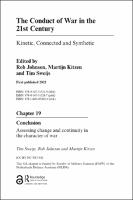Chapter 19 Conclusion
Proposal review
Assessing change and continuity in the character of war
| dc.contributor.author | Sweijs, Tim | |
| dc.contributor.author | Johnson, Rob | |
| dc.contributor.author | Kitzen, Martijn | |
| dc.date.accessioned | 2021-04-15T09:10:50Z | |
| dc.date.available | 2021-04-15T09:10:50Z | |
| dc.date.issued | 2021 | |
| dc.identifier.uri | https://library.oapen.org/handle/20.500.12657/47850 | |
| dc.description.abstract | "This book examines the key dimensions of 21st century war, and shows that orthodox thinking about war, particularly what it is and how it is fought, needs to be updated. Accelerating societal, economic, political and technological change affects how we prepare, equip and organise for war, as well as how we conduct war – both in its low-tech and high-tech forms, and whether it is with high intensity or low intensity. The volume examines changes in warfare by investigating the key features of the conduct of war during the first decades of the 21st century. Conceptually centred around the terms ‘kinetic’, ‘connected’ and ‘synthetic’, the analysis delves into a wide range of topics. The contributions discuss hybrid warfare, cyber and influence activities, machine learning and artificial intelligence, the use of armed drones and air power, the implications of the counterinsurgency experiences in Iraq, Afghanistan and Syria, as well as the consequences for law(fare) and decision making. This work will be of much interest to students of military and strategic studies, security studies and International Relations." | en_US |
| dc.language | English | en_US |
| dc.relation.ispartofseries | Routledge Advances in Defence Studies | en_US |
| dc.subject.classification | thema EDItEUR::N History and Archaeology::NH History::NHW Military history | en_US |
| dc.subject.classification | thema EDItEUR::J Society and Social Sciences::JW Warfare and defence::JWK Military and defence strategy | en_US |
| dc.subject.classification | thema EDItEUR::J Society and Social Sciences::JP Politics and government::JPS International relations | en_US |
| dc.subject.classification | thema EDItEUR::J Society and Social Sciences::JP Politics and government::JPS International relations::JPSH Espionage and secret services | en_US |
| dc.subject.classification | thema EDItEUR::J Society and Social Sciences::JW Warfare and defence | en_US |
| dc.subject.classification | thema EDItEUR::J Society and Social Sciences::JP Politics and government::JPW Political activism / Political engagement::JPWL Terrorism, armed struggle | en_US |
| dc.subject.other | Afghanistan; armed conflict; autonomous systems; cyberwar; drones; Iraq; Libya; warfare | en_US |
| dc.title | Chapter 19 Conclusion | en_US |
| dc.title.alternative | Assessing change and continuity in the character of war | en_US |
| dc.type | chapter | |
| oapen.relation.isPublishedBy | 7b3c7b10-5b1e-40b3-860e-c6dd5197f0bb | en_US |
| oapen.relation.isPartOfBook | ccf841a3-2223-4745-8e5b-4e0c41411d8b | en_US |
| oapen.relation.isbn | 9780367515249 | en_US |
| oapen.relation.isbn | 9780367515287 | en_US |
| oapen.imprint | Routledge | en_US |
| oapen.pages | 11 | en_US |
| oapen.remark.public | This OA chapter is funded by Faculty of Military Sciences (FMW) of the Netherlands Defence Academy (NLDA) | |
| peerreview.anonymity | Single-anonymised | |
| peerreview.id | bc80075c-96cc-4740-a9f3-a234bc2598f1 | |
| peerreview.open.review | No | |
| peerreview.publish.responsibility | Publisher | |
| peerreview.review.stage | Pre-publication | |
| peerreview.review.type | Proposal | |
| peerreview.reviewer.type | Internal editor | |
| peerreview.reviewer.type | External peer reviewer | |
| peerreview.title | Proposal review | |
| oapen.review.comments | Taylor & Francis open access titles are reviewed as a minimum at proposal stage by at least two external peer reviewers and an internal editor (additional reviews may be sought and additional content reviewed as required). |

